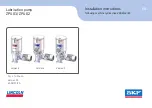
Filter Change Sheet and Normal Operation
Note: Filters are referenced in the order in which they appear in the system
1.
Sediment Filter:
This filter is first in line; removes particles that can be physically
filtered out. An example of a particle that would be removed is sand. This filter’s life
depends on the amount of particles in your water. The best gauge of this filter’s life is
pressure drop. When you see a 5PSIG drop, you should change your filter. Discoloration is
also a sign that the filter is loaded and therefore time to replace with a new filter.
2.
Carbon Block, GAC or Chloramine Blaster Filter
:
These filters
effectively reduce VOC’s (Volatile Organic Compounds) ONLY for water that is safe by
the federal Safe Water Drinking Standards.
If you have water with a known
containment, you need to treat it accordingly.
The only cost effective way to
predict filter life is by estimating the gallons. (unless carbon is being used for a know
containment, then testing is essential) The carbon block will filter 3,750 gal @ 1.0 GPM of
2ppm Chlorine (Cl
2
). A GAC will yield 5000 gallons of treated water
@ 1.0 GPM of
2ppm Chlorine (Cl
2
) . The Chloramine Blasters are run 2 in series and will yield
approximately 8000 gallons of treated water
Do
not exclude drain water from this capacity, as it is treated
water
.
3.
Reverse Osmosis Membrane
:
This is the first component in the system that
reduces Total Dissolved Solids (TDS); a common example of dissolved solids can be
salts or calcium. A TDS meter is the best way to determine if your membrane is
operating properly. A properly operating membrane will give you a TDS reduction
of at least 90%. EXAMPLE: Raw water TDS is 100ppm, after the membrane it
should be 10ppm or less. Membranes can fail by Clogging or Scaling, in which case
very little or no water will be produced. Membranes will also fail from contact with
chlorine. If this happens the water quality will be very poor. So changing the
carbon filter on time is essential. Hot water will also ruin a membrane (>80 Deg. F).
If your membrane produces significantly more than it is rated for, that is an
indication that something is wrong.
4.
Deionization Filter (DI)
:
IF USED
The DI filter is the last filter inline. This
filter consists of 2 resins. One is charged with Hydrogen (H+) and the other a
Hydroxide ion (OH-). As water passes over these resins, the remaining “salts” (or
ions) exchange out and only H+ and OH- are released into the stream. Due to the



























